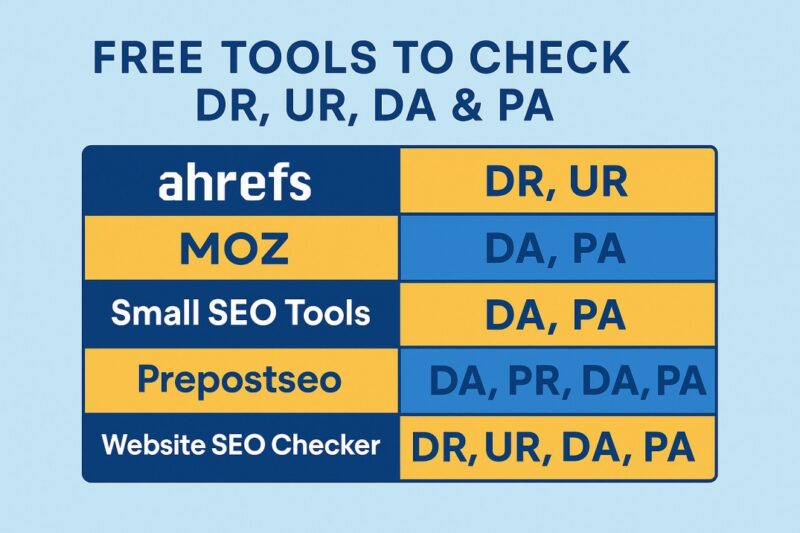If you’ve spent any time in SEO, you’ve run into a few key metrics that promise to tell you how strong your website is: Domain Rating (DR), URL Rating (UR), Domain Authority (DA), and Page Authority (PA).
They all sound similar, and they all use 0–100 scales. But they’re not the same, and understanding the difference can be the edge that helps you make smarter decisions about backlinks, content strategy, and rankings.
In this article, we’ll break it all down:
- What each metric measures
- Which tools generate them
- How they differ
- Which ones matter for your SEO goals
- How to improve each one
Let’s get into it.
Table of Contents
What Is Domain Rating (DR)?
Domain Rating is a metric from Ahrefs that measures the strength of a website’s backlink profile on a scale of 0 to 100.
It’s calculated by analyzing:
- The number of referring domains linking to your site
- The quality of those domains (high-DR sites pass more value)
- The link equity passed through followed links
It’s domain-wide, meaning it reflects the authority of your entire website, not just one page.
Why DR Matters:
- High DR sites are more trusted by search engines
- More likely to rank well for competitive terms
- Easier to get backlinks when other sites see you as authoritative
Note: DR is not a Google metric. It’s Ahrefs’ best estimate of how strong your domain looks based on backlinks.
What Is URL Rating (UR)?
URL Rating is also from Ahrefs, but it focuses on a single page, not your whole domain.
UR measures:
- The backlink profile of that specific URL
- How strong and trustworthy it is as a ranking page
It also uses a 0–100 scale and is based on link quality and quantity.
Why UR Matters:
- Helps you evaluate the strength of individual blog posts, landing pages, or product pages
- Useful for comparing top-ranking URLs when doing competitor research
- Helps identify content that may need more backlinks to perform
DR vs UR
- DR = site-wide
- UR = page-specific
A page on a DR 70 site can have a UR of 20 if it has few or no backlinks. Likewise, a single strong blog post with numerous links might have a high URL even on a low-DR site.
What Is Domain Authority (DA)?
Domain Authority is a metric developed by Moz, designed to predict how well a domain can rank in search results.
Like DR, DA is based on:
- The number of linking root domains
- The quality of those links
- Moz’s own link index (different from Ahrefs)
DA also uses a 0–100 logarithmic scale.
Why DA Matters:
- Commonly used for backlink outreach and guest posting decisions
- Many marketplaces and directories filter sites by DA
- Clients and agencies often use DA as a benchmark
However, DA updates slower than DR in many cases. And Moz’s index is smaller than Ahrefs, which can result in different scores even for the same domain.
What Is Page Authority (PA)?
Page Authority is another Moz metric, similar to DA, but for individual URLs.
It measures the predictive ranking power of a single page, based on:
- Links pointing to the page
- Moz’s internal calculations (like MozRank and MozTrust)
PA is beneficial when analyzing:
- Which pages on your site are likely to rank well
- Which competitor pages are hardest to outrank
- Internal linking opportunities to pass more authority
DR vs UR vs DA vs PA — The Big Picture
Here’s how they stack up:
| Metric | Tool | Focus | Measures | Use Case |
|---|---|---|---|---|
| DR | Ahrefs | Entire Domain | Strength of backlink profile | Domain-level authority |
| UR | Ahrefs | Single URL | Strength of a page’s backlinks | Page performance & competitiveness |
| DA | Moz | Entire Domain | Likelihood to rank in SERPs | Outreach, prospecting, PR |
| PA | Moz | Single URL | Likelihood of a page ranking | Content & backlink strategy |
No one metric tells the whole story. Smart SEOs examine all four to gain a holistic understanding of authority and ranking potential.
How to Improve Each Metric
🔹 To Increase DR (Domain Rating):
- Build high-quality backlinks from authoritative sites
- Focus on increasing unique referring domains
- Avoid spammy or irrelevant backlinks
- Create link-worthy content (stats, tools, infographics)
🔹 To Increase UR (URL Rating):
- Get targeted backlinks directly to key pages
- Use internal links to funnel authority to your focus pages
- Optimize content so it attracts natural links (evergreen posts, resource guides)
🔹 To Increase DA (Domain Authority):
- Follow similar backlink strategies as DR
- Be patient—DA updates more slowly
- Use Moz’s Link Explorer to track link growth
🔹 To Increase PA (Page Authority):
- Identify your highest potential content (based on keywords or intent)
- Build contextual backlinks to those pages
- Internally link from other high-PA pages on your site
⚠️ Important Caveats
- These are not Google metrics.
None of these (DR, UR, DA, PA) come from Google. They’re estimates created by third-party tools based on their own algorithms and data. - Chasing scores can be a distraction.
A DR of 70 doesn’t guarantee high rankings if your content is weak or irrelevant. Focus on users and value, not just metrics. - Use them as directional signals.
Use these metrics to evaluate link-building prospects, size up competitors, and set strategy—not as the only KPI for SEO success.
Free Domain Rating Checker
Free domain rating checker tools enable you to assess a website’s authority based on its backlink profile, without requiring a paid SEO subscription. These tools typically utilize data from providers like Ahrefs or Moz, providing a snapshot of your Domain Rating (DR) or Domain Authority (DA) on a 0–100 scale. While they may have usage limits or slightly less data than premium versions, they’re perfect for quick checks, competitor research, or evaluating websites before link-building outreach.
🔹 Ahrefs Free Website Authority Checker
- Metrics: DR (Domain Rating), UR (URL Rating)
- URL: CLICK HERE
- Limitations: Limited daily checks unless logged in
- Bonus: Also shows the number of backlinks and referring domains
🔹 Moz Link Explorer (Free Version)
- Metrics: DA (Domain Authority), PA (Page Authority)
- URL: CLICK HERE
- Limitations: 10 queries per month with a free account
- Bonus: See top linking domains and anchor text
🔹 Small SEO Tools – DA Checker
- Metrics: DA, PA
- URL: CLICK HERE
- Limitations: Slower results, but no login required
- Bonus: Batch checking is available for multiple domains
🔹 Prepostseo Domain Authority Checker
- Metrics: DA, PA
- URL: CLICK HERE
- Limitations: Ads and captchas, but it works well
- Bonus: Bulk checking is available

Website SEO Checker (ahrefs + Moz combo)
- Metrics: DR, UR, DA, PA
- URL: CLICK HERE
- Limitations: Slower, may be less accurate
- Bonus: Pulls from multiple sources for comparison
🧠 Pro Tip:
For more accurate data, sign up for a free trial at Ahrefs or Moz. You’ll gain full access to their tools for a limited time and receive more profound insights than those available in the free versions alone.
Final Thoughts: Which Metric Should You Trust?
Use DR and UR when you’re working with Ahrefs. They’re faster, more responsive, and backed by a massive link index.
Use DA and PA when working with Moz, especially in outreach campaigns, link marketplaces, or when collaborating with agencies that still prioritize DA.
Here’s the rule of thumb:
- Want to grow your brand’s authority? → Focus on DR/DA
- Want to boost a key page’s ranking? → Focus on UR/PA
- Want to win at SEO? → Build great content, earn legit links, and monitor all four metrics to stay ahead

Andrej Fedek is the creator and the one-person owner of two blogs: InterCool Studio and CareersMomentum. As an experienced marketer, he is driven by turning leads into customers with White Hat SEO techniques. Besides being a boss, he is a real team player with a great sense of equality.
